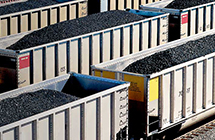 |
 |
|
| eNews • May 2017 | ||
| Promoting a Cost-Effective, Reliable and Competitive Transportation System |
||
 Union Pacific appears poised for rebound as demand for shipping rises
Union Pacific appears poised for rebound as demand for shipping rises
Union Pacific appears set to break a two-year streak of falling shipments, as more expensive natural gas has boosted demand for train-hauled coal at the nationââ¬â¢s electric utilities.
Wall Street analysts surveyed by Bloomberg expect earnings per share of $1.23, on adjusted net income of $1 billion, 2.6 percent higher than a year earlier. Analysts forecast quarterly revenue at the second-largest U.S. railroad by ton-miles to rise 4 percent to $5 billion.
As for the cargo numbers, they appear encouraging: Total Union Pacific shipments of commodities, ag products, finished goods and the rest of the material that makes the world go rose 2 percent through the first 16 weeks of the year, according to reports filed with the Association of American Railroads. If that holds, it would mean Union Pacific would report the first quarter of rising cargo demand since 2015.
ââ¬Å"I believe we will finally see gains in overall shipments for Union Pacific in the first quarter, reversing eight straight quarters of negative movement,ââ¬Â said Daniel Sherman, transportation industry analyst for St. Louis-based wealth adviser Edward Jones. ââ¬Å"The record U.S. grain harvest in 2016 was slow to ship at the end of last year, and should boost grain shipments in the first quarter by double-digits.ââ¬Â
But the real bright spot is coal - a bread-and-butter rail industry standby that has been trodden into dust in recent years as electric utilities have chosen to increasingly burn cheaper and cleaner natural gas.
But everything has its price. A year ago, natural gas sold for $1.92 per million British thermal units. It approached $3.60 per Btu in recent months and is hovering around $3.
And all of that makes heavy, transport-intensive coal an option some electric utilities are embracing. And railroads are the only economical way to haul the mineral.
ââ¬Å"With higher natural gas prices than this time last year, coal volumes should show double-digit growth,ââ¬Â Sherman said.
The trend is already promising. AAR, the railroad association, said shipments of coal by the seven Class I railroads rose 30 percent so far this year through mid-April. At Union Pacific, coal volumes rose 19 percent in the same period.
All told, it might shape up into good news for everyone at Union Pacific, which trails only Berkshire Hathaway-owned BNSF Railway. The company said at an investor conference last month that it had about 1,700 hourly line workers on furlough or other work status, and about 1,200 locomotives in storage.
Both figures were improvements, as the company in September reported having 2,700 workers on furlough and 1,600 locomotives in storage. Union Pacific employs about 43,000 people operating about 32,000 miles of track in 23 Western states.
As for investors, they will be looking for the company to not only increase volume, but to beat earnings estimates. Bloomberg Intelligence said in an investor note this month that ââ¬Å"exceeding consensus expectation will be driven by how quicklyââ¬Â the company has enacted what it said this year will amount to as much as $400 million in operating efficiencies such as decreasing the time trains spend idle.
Shares of Union Pacific have risen about 26 percent in the past year or so, as investors saw a sell-off that sent shares below $70 each last year as overdone. The industry is divided into geographic territories by federal regulators, making it unlikely that any new major freight hauling railroads will ever be formed.
There still might be some upside, however. Analysts at Aegis Capital wrote in an investor note this month that they expect shares to reach $120 each.
ââ¬Å"As an industry, railroads have much to look forward to as coal supply and demand normalizes,ââ¬Â Aegis wrote, also citing the promise of increased crude oil-by-rail hauling as rising prices motivate additional production from northern U.S. fields not well served by pipelines.
Union Pacific shares closed up more than 1 percent on a day when the broader market was up similarly. They fetched $110.48 each on the New York Stock Exchange.
Source: Omaha World Herald
Soy Transportation Coalition |
|
